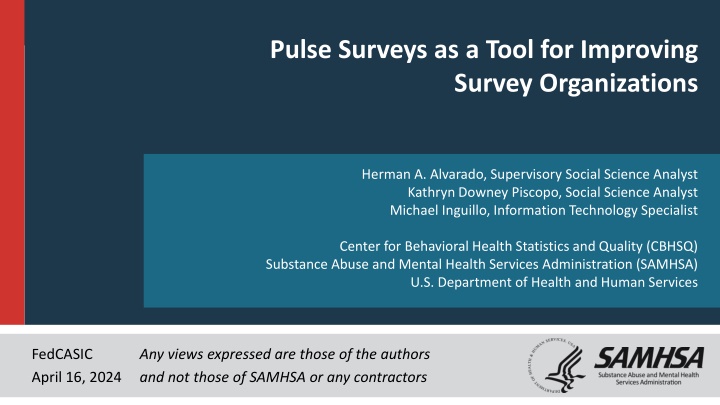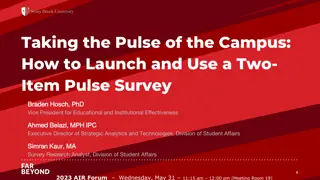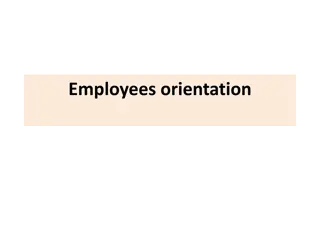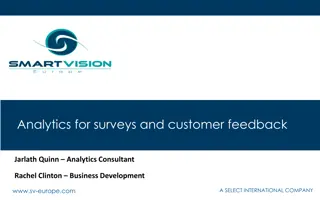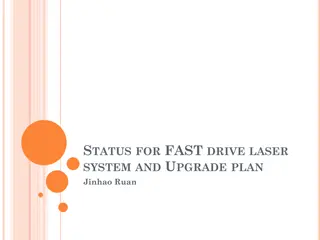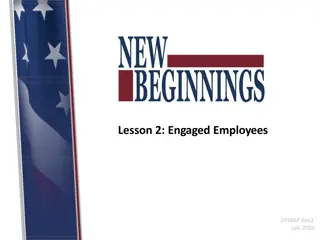Enhancing Organizational Feedback with Employee Pulse Surveys
Employee Pulse Surveys are short, frequent questionnaires used by organizations to gather valuable feedback and insights from employees. This tool helps in understanding employee perceptions, satisfaction, and engagement levels, enabling leaders to make data-driven decisions for improving the workplace environment. Learn about the characteristics, benefits, and risks associated with implementing Employee Pulse Surveys to enhance organizational effectiveness.
Download Presentation

Please find below an Image/Link to download the presentation.
The content on the website is provided AS IS for your information and personal use only. It may not be sold, licensed, or shared on other websites without obtaining consent from the author.If you encounter any issues during the download, it is possible that the publisher has removed the file from their server.
You are allowed to download the files provided on this website for personal or commercial use, subject to the condition that they are used lawfully. All files are the property of their respective owners.
The content on the website is provided AS IS for your information and personal use only. It may not be sold, licensed, or shared on other websites without obtaining consent from the author.
E N D
Presentation Transcript
Pulse Surveys as a Tool for Improving Survey Organizations Herman A. Alvarado, Supervisory Social Science Analyst Kathryn Downey Piscopo, Social Science Analyst Michael Inguillo, Information Technology Specialist Center for Behavioral Health Statistics and Quality (CBHSQ) Substance Abuse and Mental Health Services Administration (SAMHSA) U.S. Department of Health and Human Services FedCASIC April 16, 2024 Any views expressed are those of the authors and not those of SAMHSA or any contractors
What are Pulse Surveys? Short set of questions One or more topics Emerging issues Follow up on focus area(s) Used in different contexts: Household Pulse Survey (Census) Employee pulse surveys 2
What is an Employee Pulse Survey? A method used by organizations to gather feedback and insights from their employees. It involves administering a set of questions or statements to employees to gauge their perceptions, satisfaction, and engagement levels within the workplace. (Ganesh, 2023) In some organizations, it is also referred to as an engagement survey 3
Characteristics of Employee Pulse Surveys Short, easy to respond to Frequent administration Easy-to-reach audience (internal plus frame available) Goals: Provide an immediate snapshot of employee opinions and experiences Frequency allows building of comparative data and identification of potential trends 4
Benefits (Jolton & Klein, 2020) Provides organizations information on hot topics or reactions to recent organizational events Increases leadership involvement on continuous listening efforts Can increase acceptance of organizational, environmental and/or administrative changes, when employee feedback is incorporated within these changes ( increased connectivity ) 5
Risks (Jolton & Klein, 2020) Over-surveying and survey fatigue Poor questionnaire design can lead to poor information Perception that survey focus is on tracking rather than action and change Accountability not always clear who is the final decision-maker? 6
Pulse Surveys in Survey Organizations Center for Behavioral Health Statistics and Quality (CBHSQ) at the Substance Abuse and Mental Health Services Administration (SAMHSA) Federally-recognized statistical unit (RSU) by OMB CBHSQ collects, analyzes and reports data on substance use and mental health disorders from multiple sources (e.g., general population (12+), treatment facilities, emergency department visits, admission records, and state administrative records) CBHSQ annually conducts the National Survey on Drug Use and Health (NSDUH), which provides nationally representative data on tobacco, alcohol, and drug use; substance use and mental disorders; and receipt of substance use and mental health treatment Staff is a mix of statisticians, health professionals, behavioral scientists, social science analysts, program analysts, survey researchers, and other professional series with different years of experience in their respective fields Staff has experience in different work settings (government, industry, academia) 7
Examples of Pulse Surveys Used at SAMHSA/CBHSQ Gather information on training and work support Ask for specific details on workplace issues Collect information in preparation for a meeting or event Follow-up to a major event or meeting 8
Gather Information on Training and Work Support CBHSQ Pulse Survey (November 2022) 9
Ask for Specific Details on Workplace Issues FY24 CBHSQ Staff Pulse Survey (October 2023) 10
Collect Information in Preparation for Meeting/Event CBHSQ COR Community of Practice (January 2024) 11
Follow Up to a Major Meeting or Event CBHSQ COR Community of Practice (April 2023) 12
How Pulse Surveys Improve Organizations? For meetings/events Establish priorities Group topics or questions Management Establish priorities Identify training needs Identify pressing issues that must be addressed (e.g., building morale, program/operations improvement, etc.) Identify areas for improvement or growth Connect feedback with concrete actions 13
Lessons Learned Software selection Skip patterns Wrapping text Distribution and monitoring Do not expect 100% response rate Even when pulse surveys are anonymous, staff may still have confidentiality concerns Risk of that respondents will avoid/ignore open- ended questions Always test every version before launching 14
Thank You! SAMHSA s mission is to lead public health and service delivery efforts that promote mental health, prevent substance misuse, and provide treatments and support to foster recovery while ensuring equitable access and better outcomes. Herman.Alvarado@samhsa.hhs.gov www.samhsa.gov 1-877-SAMHSA-7 (1-877-726-4727) 1-800-487-4889 (TDD) 15
